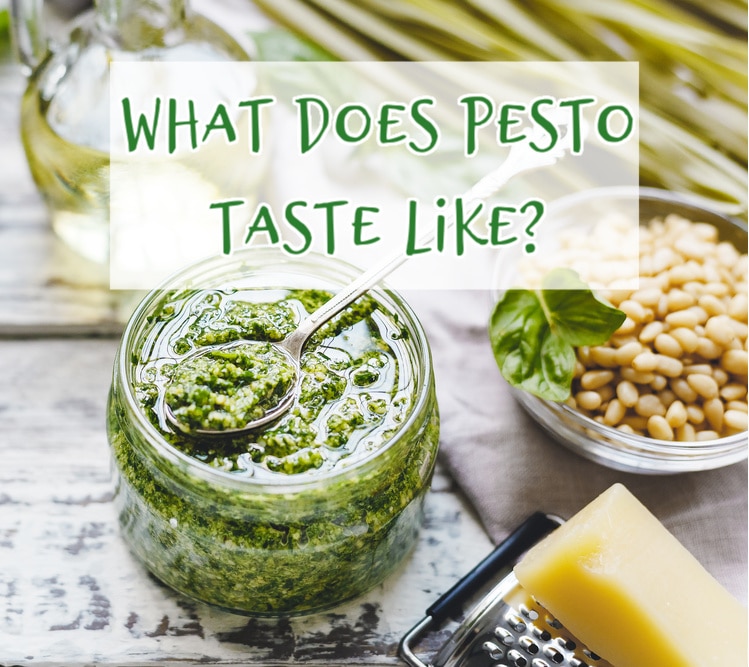Have you ever wondered what pesto tastes like?
This versatile sauce, with its rich flavors and health benefits, is a culinary delight.
Made with pine nuts and extra-virgin olive oil, pesto can be used in countless ways and paired with a myriad of foods.
Join us as we explore the endless flavor combinations and recipe options that pesto has to offer.
what does pesto taste like
Pesto has a distinct and vibrant flavor that is both herbaceous and nutty.
The traditional combination of fresh basil, garlic, pine nuts, Parmesan cheese, and extra-virgin olive oil creates a rich and complex taste.
Pesto sauce can be described as refreshing, with a hint of sweetness from the basil and a slightly savory note from the Parmesan.
The addition of pine nuts gives the sauce a creamy texture and adds a nutty undertone.
Overall, pesto is a versatile sauce that can enhance the flavor of various dishes, from pasta to sandwiches, and can be paired with roasted or raw vegetables, meat, fish, shellfish, cheese, or even used as a dip or marinade.
Homemade pesto should be stored in an airtight container in the refrigerator for up to a week, while store-bought pesto can be stored in the refrigerator for a longer period.
Key Points:
- Pesto has a distinct and vibrant flavor that is herbaceous and nutty
- The traditional combination creates a rich and complex taste
- Pesto sauce is refreshing with a hint of sweetness and a slightly savory note
- The addition of pine nuts gives the sauce a creamy texture and nutty undertone
- Pesto is versatile and can enhance various dishes
- Homemade pesto can be stored for up to a week, while store-bought pesto can be stored longer
what does pesto taste like – Watch Video
💡
Pro Tips:
1. Pesto, a classic Italian sauce, originated in the Liguria region of northwest Italy, specifically in the city of Genoa.
2. Traditionally, pesto is made by grinding together fresh basil leaves, garlic, pine nuts, Parmesan cheese, and olive oil using a mortar and pestle, which gives it a unique texture.
3. The word “pesto” comes from the Genoese verb “pestâ,” which means “to pound” or “to crush.” This refers to the traditional method used to make pesto.
4. Pesto is traditionally served with pasta, but it can also be used as a base for pizza, as a spread on sandwiches, or as a dip for bread or vegetables.
5. While the most common type of pesto is made with basil, there are numerous variations using different herbs and ingredients. For example, you can find pesto made with arugula, sun-dried tomatoes, cilantro, or even kale. Each variation adds a unique flavor profile to the sauce.
Pesto Taste: Exploring The Flavor Profile
Pesto is a traditional Italian sauce known for its vibrant and distinct flavor. It is primarily made with fresh basil, garlic, pine nuts, Parmesan cheese, and extra-virgin olive oil.
The taste of pesto can be described as herbaceous, nutty, and slightly tangy. The fresh basil provides a fresh and aromatic flavor, while the garlic adds a sharp kick. The rich and creamy texture of the sauce, combined with the mild bitterness of the Parmesan cheese, creates a well-balanced and complex taste.
Pesto is a delightful explosion of flavors that can elevate any dish it is added to.
Benefits of using pesto sauce:
- Adds a burst of flavor to dishes
- Complements a variety of ingredients
- Enhances the taste of pasta, sandwiches, salads, and more
- Can be used as a marinade or dip
- Provides a nutrient-rich option with the inclusion of basil, pine nuts, and olive oil
“Pesto is more than a sauce; it is a flavor-packed experience that leaves taste buds wanting more.”
Health Benefits Of Pesto: A Nutritious Choice
Pesto not only tastes delicious but also offers several health benefits. Basil, the main ingredient in pesto, is packed with essential nutrients such as vitamin K, vitamin A, and antioxidants. These nutrients help support bone health, promote healthy vision, and protect the body against free radicals.
In addition, garlic, another key component of pesto, has been associated with numerous health benefits. It is known for boosting the immune system and reducing the risk of cardiovascular diseases.
Furthermore, extra-virgin olive oil in pesto is rich in monounsaturated fatty acids, which have a positive impact on heart health.
To summarize the health benefits of pesto:
- Basil provides essential nutrients like vitamin K, vitamin A, and antioxidants.
- Garlic boosts the immune system and reduces the risk of cardiovascular diseases.
- Extra-virgin olive oil is rich in heart-healthy monounsaturated fatty acids.
Pine Nuts: A Protein Source In Pesto
One of the ingredients that give pesto its unique flavor and texture is pine nuts. These small, cream-colored nuts are a great source of protein and healthy fats. They add a subtle, buttery taste to the sauce and contribute to its creamy consistency.
Pine nuts are also a rich source of essential minerals such as magnesium and zinc, which play a vital role in supporting various bodily functions. Including pine nuts in your pesto not only enhances its taste but also adds nutritional value.
- Pine nuts are a great source of protein and healthy fats
- They add a subtle, buttery taste to the sauce
- Pine nuts contribute to the creamy consistency of pesto
- Rich in magnesium and zinc, which are essential minerals
- Enhances the taste and adds nutritional value to pesto
“Including pine nuts in your pesto not only enhances its taste but also adds nutritional value.”
Extra-Virgin Olive Oil: Rich In Fatty Acids
Another key ingredient in pesto is extra-virgin olive oil. This type of oil is known for its high content of monounsaturated fatty acids, particularly oleic acid. These fatty acids have been shown to reduce inflammation, improve heart health, and support brain function. Extra-virgin olive oil also contains antioxidants that help protect the body against oxidative stress. When combined with the other ingredients in pesto, extra-virgin olive oil adds a smooth and velvety texture, as well as a delightful fruity aroma that enhances the overall taste of the sauce.
Versatile Ways To Use Pesto Sauce
Pesto sauce is an incredibly versatile condiment that can enhance the flavor of many different dishes. Its traditional use is as a pasta sauce, where it adds a rich and flavorful essence to the noodles. However, pesto can also be used as a marinara sauce for meat or seafood, providing a tangy and delicious twist. It can be used as a spread for sandwiches, adding a burst of flavor, or as a dip for fresh vegetables, adding a refreshing kick.
Moreover, pesto sauce can serve as a marinade for chicken or fish, infusing them with its delicious flavors. This versatility allows for endless possibilities in the kitchen. Pesto sauce can even be included in a cheeseboard, complementing different types of cheeses and enhancing their taste.
With its numerous uses, pesto sauce is undoubtedly a pantry staple that can be easily incorporated into a variety of dishes.
Storage Tips For Homemade And Store-Bought Pesto
When it comes to storing pesto, there are a few important tips to keep in mind:
- Homemade pesto can be stored in an airtight container in the refrigerator for up to a week.
- To prolong its shelf life, you can also freeze homemade pesto in ice cube trays and transfer the frozen cubes to a freezer bag for up to 6 months.
- Store-bought pesto usually comes in a sealed jar, and once opened, it should be refrigerated and used within a week.
- However, if you want to extend its shelf life, you can transfer store-bought pesto to an airtight container and place a layer of olive oil on top to create a seal, which can help preserve its freshness for up to two weeks.
Foods That Pair Well With Pesto Sauce
Pesto sauce is incredibly versatile and pairs well with a variety of foods. It can be drizzled over roasted or raw vegetables, adding a burst of flavor to their natural sweetness. Pesto is also a fantastic complement to meats such as chicken, fish, or shellfish, adding a vibrant and tangy element to the dish.
When it comes to cheese, pesto pairs perfectly with mozzarella, Parmesan, or goat cheese, creating a harmonious fusion of flavors. If you’re looking to add a twist to your favorite dishes, try spreading pesto on pizza, tossing it with pasta, smearing it on garlic bread or crackers, or even using it as a topping for citrus-infused salads.
The possibilities are endless and each combination brings a unique and delicious experience.
- Pesto sauce can be drizzled over roasted or raw vegetables.
- It pairs well with meats like chicken, fish, or shellfish.
- Pesto complements mozzarella, Parmesan, or goat cheese.
- Try spreading pesto on pizza, tossing it with pasta, smearing it on garlic bread or crackers, or using it as a topping for citrus-infused salads.
Pesto Flavor Combinations To Try
There are numerous exciting flavor combinations you can experiment with when using pesto.
For example, try combining turkey breast, avocado, and baguette for a tasty sandwich. The freshness of the turkey and avocado pairs beautifully with the herby pesto, all nestled between slices of crusty baguette.
Another great combination is tomatoes, mozzarella cheese, and roasted peppers. The juicy sweetness of the tomatoes, the creamy richness of the cheese, and the smoky notes of the roasted peppers create a perfect balance when paired with pesto.
And if you’re looking for a vegetarian option, try roasted or grilled eggplant, zucchini, tomatoes, and Parmesan cheese. The medley of flavors and textures is enhanced by the addition of pesto, creating a delightful dish that bursts with freshness and depth.
Bullet points:
- Turkey breast, avocado, and baguette
- Tomatoes, mozzarella cheese, and roasted peppers
- Roasted or grilled eggplant, zucchini, tomatoes, and Parmesan cheese
Delicious Pesto Recipes To Experiment With
If you’re looking to experiment with pesto beyond the classic basil version, here are a few recipes to try.
-
For a twist on traditional pesto, you can make an easy basil cashew pesto sauce by replacing the pine nuts with cashews. The creamy cashews add a unique flavor and texture to the sauce while still maintaining its signature taste.
-
Another delicious variation is asparagus pesto, which highlights the flavors of the fresh green vegetable. Simply blend blanched asparagus with garlic, Parmesan cheese, pine nuts, and olive oil, and you’ll have a vibrant and nutritious sauce that pairs perfectly with any pasta dish.
-
If you’re feeling adventurous, try garlic scape pesto, which utilizes the green shoots from garlic plants. The mild garlic flavor combined with the freshness of the scape creates a pesto with a distinct taste that will leave you wanting more.
-
And for a vibrant and wholesome option, try broccoli walnut pesto, where the earthy taste of walnuts complements the cruciferous vegetable perfectly.
-
Finally, don’t miss out on the opportunity to combine the peppery taste of arugula with the classic basil and walnuts in an arugula pesto sauce. This variation adds a bold and slightly spicy twist to your pesto repertoire.
Exploring Different Varieties: From Basil To Broccoli Pesto
Pesto: Exploring Delightful Varieties
While basil pesto is the most well-known variety, there are many other delightful versions to explore. Some popular ones include sun-dried tomato pesto, cilantro pesto, spinach pesto, and even broccoli pesto. Each of these varieties brings its own unique flavors and can be the star of various dishes.
- Sun-dried tomato pesto offers a rich and intense flavor.
- Cilantro pesto adds a fresh and citrusy note to your meals.
- Spinach pesto is a great option for those looking for a milder and more subtle taste.
- Broccoli pesto combines the nutritional benefits of broccoli with the fantastic taste of pesto.
Exploring different pesto varieties allows you to customize your dishes and discover new and exciting flavor combinations.
“Pesto is a flavor-packed sauce that offers a delightful blend of fresh herbs, rich nuts, tangy cheese, and fruity olive oil.”
Pesto is a versatile condiment that can be used in a range of dishes, providing unique and vibrant flavors. From its health benefits to its endless pairing possibilities, pesto is a true gastronomic delight. So, next time you’re looking to add a burst of flavor to your dishes, reach for the pesto and embark on a flavorful exploration.
- Basil pesto – classic and popular
- Sun-dried tomato pesto – rich and intense flavor
- Cilantro pesto – fresh and citrusy note
- Spinach pesto – mild and subtle taste
- Broccoli pesto – combines nutrition and taste
💡
You may need to know these questions about what does pesto taste like
Does pesto sauce taste good?
Pesto sauce is a culinary delight with its harmonious blend of herbs, garlic, and nuttiness. The addition of parmesan cheese enhances its flavor with a touch of saltiness and savoriness that perfectly complements the overall taste. The freshness and aromatic scent of pesto further contribute to its deliciousness, making it an irresistible and appetizing choice for any dish.
How would you describe pesto sauce?
Pesto sauce, a delightfully verdant concoction, immerses the palate in a symphony of vibrant and invigorating flavors. With its prominent notes of basil, this sauce exudes an herbaceous essence reminiscent of an abundant garden. Embodied in a velvety olive oil base, it is further elevated by the subtle crunch of pine nuts and the robust contributions of Italian cheeses and garlic, resulting in a harmonious medley that tantalizes the taste buds.
Is pesto strong?
In terms of flavor, pesto can indeed be considered strong due to its pungency. However, there are ways to slightly reduce this intensity and enhance its overall taste profile. Opting for a mild olive oil, substituting Romano cheese with Pecorino Sardo, and refraining from toasting the pine nuts are all effective strategies to bring a sweeter, more balanced flavor to the sauce. These alterations can help to temper the robustness of pesto while maintaining its distinct character.
How is pesto traditionally eaten?
Traditionally, pesto is enjoyed in a variety of ways, with pasta being the most common pairing. It is often served with mandilli de sæa, delicately thin pasta sheets resembling silk handkerchiefs. Additionally, it is frequently savored with trofie or trenette, pasta shapes that are perfect for soaking up the flavors of the vibrant pesto sauce. In a delightful twist, locals often include boiled potatoes and string beans in the same pot as the pasta, resulting in a harmonious blend of flavors that heightens the overall taste experience. This traditional combination showcases the versatility of pesto and adds a delightful textural element to the dish.
Reference source
https://myfoodbook.com.au/tips/how-to-make-pesto
https://simpleandsavory.com/what-does-pesto-taste-like/
https://www.paesana.com/blog/why-we-love-pesto-sauce
https://www.cooksmarts.com/articles/creative-ways-to-use-pesto/



